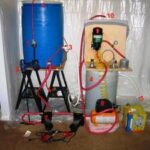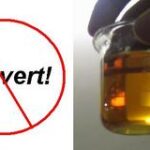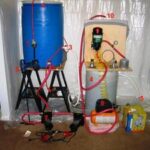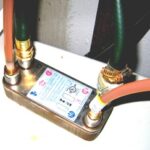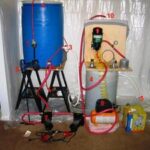BIODIESEL INTRO
I’ve written a couple articles already about my experiences with biodiesel, and you can read them here and here and (most of all) here. I write this article to possibly debunk the idea (misconception?) that you absolutely have to convert you car for biodiesel, and thus possibly save you thousands of hard-earned dollars in the meantime.
Read this article before you by any wonder-magic “biodiesel conversion kit”.
THE NEVER-ENDING QUESTION
I drive my car around and it smells like french fries – well… crab puffs in my case, because I get my recycled veggie oil from a Chinese restaurant. Sometimes people see me dumping a few gallons of the greasy brown stuff into my tank. We get to talking, and then eventually the big question pops up:
“So, what would I have to do to convert my diesel car to run biodiesel?”
Invariably I say, “Probably nothing?”
After that the puzzled frown appears, and then, “Why? I saw a TV show that says these cars have to be converted.”
That’s because the people running those shows don’t know any better, and they are dedicated to the sensationalism of new gizmos and gadgets – “leading-edge technology”.
How about low-tech that simply works?
THE ANSWER
They pop the question again.
I say that it depends on how your car reacts to biodiesel, what kind of weather you run it in, etc. In the end, I tell them that they have to do some research on their specific car, try a few things and make their own decision.
I make sure to tell them to try what I tried, too.
In my case, I found I had to do absolutely nothing to convert my car for biodiesel, even for winter use.
HERE’S THE DEAL
Think of using biodiesel as a two-sided equation – two parts interacting with one another. These two equations are:
– your diesel car’s engine, and
– the biodiesel fuel you will run through the engine
How these two sides interact with one another determines whether you will need to “do a conversion”.
Yes, in warm or temperate weather (generally above 50 degrees F) you usually won’t need to do anything to get biodiesel to run in your engine. The determining issue here is: whether the fuel remains fluid enough to run through your fuel lines for proper delivery to the engine? The answer is, yes, in warm weather it will generally run fine.
Because biodiesel fuel is more viscous than regular diesel fuel, some folks like to pre-heat their biodiesel so that it atomized into smaller droplets when going through the fuel injectors. This smaller atomization produces a more efficient burn, and may reduce the amount of fuel one needs to use to run the car. This pre-heating can be done in various ways – but I won’t get into this because pre-heating is not a requirement to make your car run with biodiesel.
WHY CONVERT?
The “real issue” is whether you need to convert or somehow modify your car for using biodiesel in the winter.
In the winter, biodiesel tends to freeze up, gelatinize, and will stall or at least significantly reduce engine power (I went through the whole gelatinizing problem myself a few times – stuck out in the freezing night-time countryside with a stalled motor – not pleasant at all).
Problem is: these “conversion kits” can be outright expensive – upward of $4000 or more. They require some serious modification to your car and the usually the skilled hands of some geek to install it. Then you have to pay the geek’s installation bill. In the end, you are left with an empty pocket and a fancy fuel heating system that might or might not work, and a voided warranty on your car service policy (if still in effect). Is it worth it?
If money is not an issue, then yes, you can fork out some serious dough and “convert” for winter. But I ask you to go back to the “two-sided equation” idea above: you are modifying the car to fit the fuel’s limitation.
Here’s the ten-million dollar question:
How about modifying the fuel instead?
WHAT’S THE REAL ISSUE HERE?
The angle is simple. Modifying the fuel is cheaper, allows for more flexibility in experimentation, and – quite simply – it works.
One way: some folks go the easy route and mix their biodiesel fuel in varying ratios with regular diesel fuel to keep the biodiesel oil from freezing. But:
– What if you only want to fill up your tank after it’s only been partly emptied part-way? And you end up messing up the ratio you put in and it gels? There you are: stuck on a freezing highway with no engine to run and at least keep you warm.
– How about if there’s a sudden cold snap and the ratio you mixed at isn’t good enough to keep the bio-oil from freezing at this new lower temperature? There you are, stuck again.
Additionally, I didn’t want to buy any more diesel fuel. Period. I’m sick of fuel prices and I’m sick of lining the pockets of some greedy smirking oil company shareholder. How to beat Mr. Smirk?
“THE GOLDEN EGG” – PAINT THINNER
I discovered a pretty good solution. At least it works for me. It’s cheap and simple, and after several winters of doing this already, I’ve had no ill effects on my engine.
My solution: 5% or less by volume of paint thinner or mineral spirits in my biodiesel fuel. For me and my bio-fuel, it’s good down to minus 15 degrees F. No gelling, no freezing. Good enough for me and my Midwestern winter weather.
CAUTION
Some folks will read this and cry foul. Rightly so. Maybe they had a bad experience. And there are other factors to consider besides the winter cold issue – such as rubber components’ compatibility with biodiesel. I am only addressing the winterizing issue here, folks.
Maybe they will say that paint thinner is bad for your car parts: injectors, fuel pumps, cylinder walls, blah-blah… Well, sure, go ahead and do research and experiment. Nothings matters like seeing what actually works. Just do it.
Otherwise, my reaction: Hey, then don’t use biodiesel.
I agree, using biodiesel is still not a refined science. At this point it’s more an art than science. As of this writing no motor company endorses using pure veggie in their diesel engine cars, even low-veggie blends. For those auto makers that may allow biodiesel, they only do so with severe limitations and they make sure to include all the fine print to cover themselves in case you and your car go awry.
My experience says: using paint thinner is OK. And sure, I do so at my own risk.
But so far the risk had paid off.
After three winters, the car still runs well, still gets 46 miles to the gallon, and my journeyman mechanic raved at how clean and well-running the engine was last time he took it apart to change the valve belt (normal maintenance for a car that ran for 100,000 miles on biodiesel).
CONCLUSION
So, folks. Before you go running off to buy a fancy “winterizing system” (with all these extra parts and systems that may break down on you), try modifying the fuel instead of the car.
Going at the problem from the other side of the equation may save you a lot of expense, and headache in the long run.
Have fun!
– John
Hey! Read John’s other articles at:
http://www.associatedcontent.com/johnmelendez
